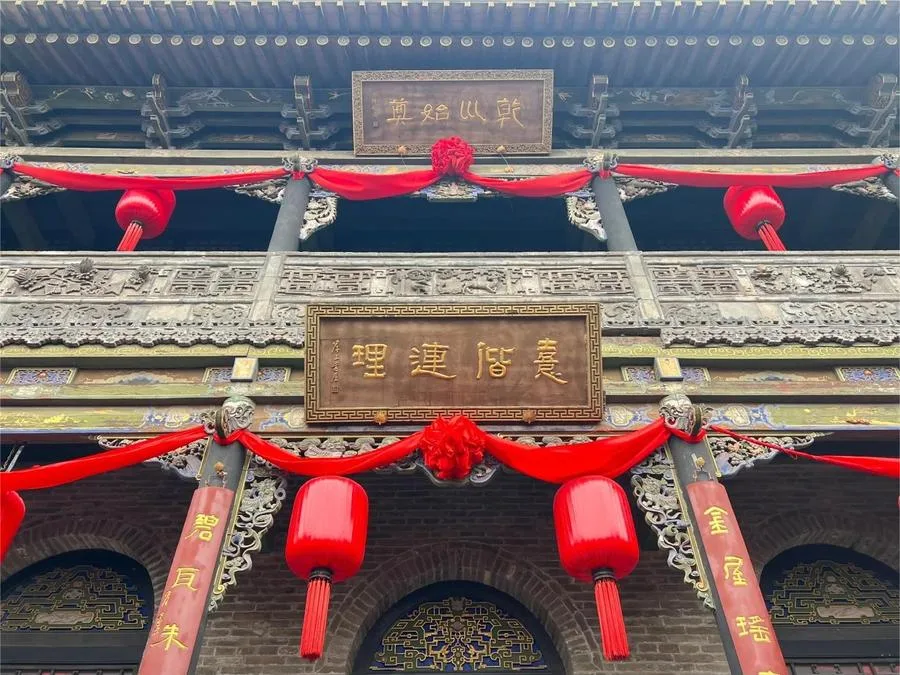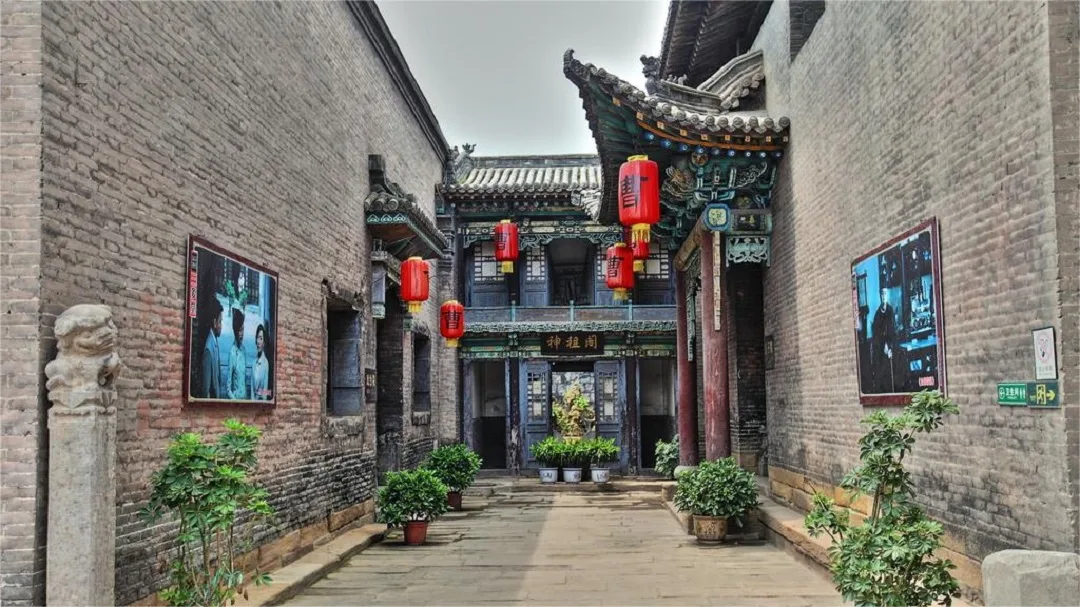The Cao Family Compound (曹家大院), also known as San Duo Tang (三多堂, Three More Hall), derives its name from the concepts of “more happiness, more longevity, and more descendants.” This historic residence, built by the wealthy Cao family during the Ming and Qing dynasties, covers 10,600 square meters and consists of 15 courtyards, with a history spanning over 400 years.
The compound is divided into northern and southern sections and features three parallel courtyards running east to west, each flanked by three four-story hall buildings. The rooftops of these halls are adorned with pavilions shaped like the three sacred animals: pig, cow, and sheep. The overall layout of the compound forms the Chinese character for “longevity” (寿).
Blending northern and southern architectural styles with elements of European classical design, the Cao Family Compound is a prime example of traditional northern Chinese residential architecture. In 1999, it was converted into a museum displaying four main exhibitions with twelve thematic sections, featuring thousands of cultural relics and artifacts, including Ming and Qing classical furniture and treasures such as the “Hundred Longevity Screen” made from 92 pieces of natural patterned marble and a golden locomotive clock in the treasure hall.
Table of Contents
- Basic Information
- Location and Transportation
- Highlights of Cao Family Compound
- Vlog about Cao Family Compound
- History of Cao Family
- Other Compounds in Jinzhong City
Basic Information
| Estimated Length of Tour | 1 – 2 hours |
| Ticket Price | 45 RMB |
| Opening Hours | 9.00 – 17.00; Last admission: 16.30 |
| Telephone Number | 0086-0354-6130021 |
Location and Transportation
The Cao Family Compound is located in Beihuang Village, Beihuang Township, Taigu District, Jinzhong City, Shanxi Province. To get there, you can choose one of the following ways:
- By Bus: Take a bus from the Jianan Bus Station in Taiyuan to Taigu County. The ticket costs approximately 14 RMB. Upon reaching Taigu County, you can hire a car to the Cao Family Compound.
- By Public Transport: Alternatively, from Juxianlou Restaurant in Taigu County, you can catch a local bus to the San Duotang Tourist Area. Buses run from 8:00 AM to 4:00 PM.
Highlights of Cao Family Compound
Cao Family Commercial History

The exhibit on the Cao family’s commercial history showcases their journey from humble beginnings to peak success and eventual decline. It highlights the family’s early entrepreneurial struggles, depicted by the phrase “working from sunrise to sunset.” The period of prosperity is illustrated with displays such as “600 buildings in Liao, Feng, Mongol, and Russian regions” and the “Four Happinesses” motifs. The decline is poignantly represented by the scene “a puff of white smoke in an instant, a millennium of tiles and gold falling.”
Ming and Qing Furniture Exhibition

The furniture exhibit features over 400 pieces of Ming and Qing dynasty furniture. Notable items include the rare “Hundred Longevity Screen,” crafted from 92 pieces of naturally patterned marble, and the “Redwood Semi-Circular Table,” symbolizing the phrase “寸斤寸金” (“every inch of wood is worth an inch of gold”). Other highlights are the intricately designed “Marble Vanity Mirror” and various classic pieces that exemplify the craftsmanship of the era.
Porcelain Exhibition

The porcelain exhibit includes nearly 2,000 items, ranging from vases and jars to plates and bowls. In the “Treasures Hall,” a Qing dynasty treasure, the “Golden Locomotive Clock,” is featured. This clock, a gift from France to the Qing court, is made from yellow, white, and black gold, weighing 84.50 pounds. It includes a clock and barometer, and can move along a track due to its high-quality spring. Another notable treasure is a Ming dynasty copy of the Song dynasty’s “Along the River During the Qingming Festival” by the renowned painter Qiu Ying. This scroll, 7.74 meters long and 0.45 meters wide, depicts 1,643 figures and 208 animals. Other valuable items on display include feather mirrors, Shang dynasty white ceramic pigeons, and Ge kiln porcelain fragments.
Vlog about Cao Family Compound
History of Cao Family
The Cao family traces its origins to Cao Bangyan from Huata Village, Taiyuan. Originally a seller of clay pots, Cao Bangyan moved with his family to Beihuang Village in Taiyuan during the Ming Hongwu period, where they also engaged in farming. The family’s fortune began to rise with Cao Sanxi, a 14th-generation member who ventured into trade in the northeast. His success was significant, and by this time, Cao family businesses were well-known in the “Seven Halls Outside the Pass.”
As the Qing forces entered China, the Cao family expanded their business into the interior, establishing a shop in Taigu and spreading their influence nationwide. During the Daoguang and Xianfeng periods, the Cao family’s business reached its zenith, with over 640 shops across China and assets totaling 12 million taels of silver. They employed 37,000 workers, leading to the saying, “Wherever a sparrow flies, there is a Cao shop.” The family also expanded internationally, exporting Chinese tea and cloth while importing steel from Japan, ginseng from Korea, and metal products from Russia. Their trade routes between Shanxi and Mongolia became known as the “Tea Route,” rivaling the historical Silk Road in importance.
However, after the events of the Jiawu and Gengzi years, including wars, commercial competition, and the extravagance of descendants, the Cao family business declined. At its peak, the Cao family built several grand and elaborate residences in Beihuang Village, such as Wuguitang, Huaiyitang, Fushantang, and Sanduotang. Among them, the “Longevity” residence, known as Sanduotang, remains as a representative example, reflecting the family’s legacy of prosperity, longevity, and numerous descendants.







